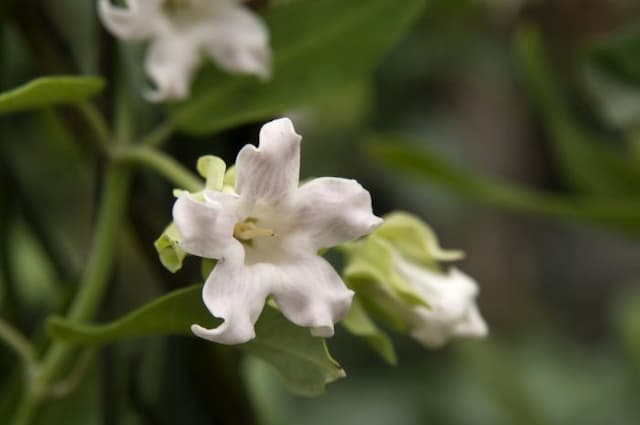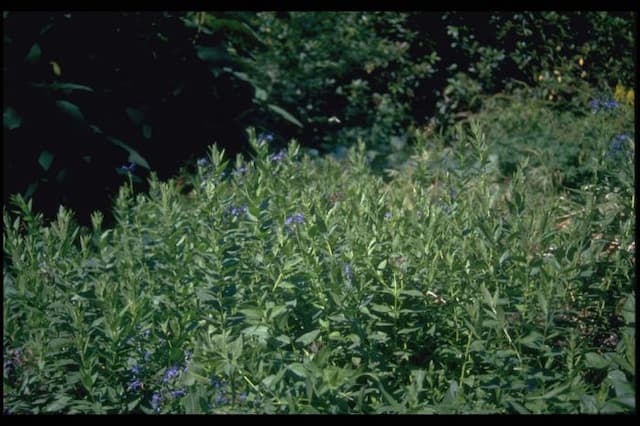White lesser periwinkle Vinca minor f. alba 'Gertrude Jekyll'

ABOUT
The plant commonly known as Periwinkle 'Gertrude Jekyll' is a charming, low-growing perennial that is noted for its eye-catching and attractive features. It has a dense mat of small, ovate to lance-shaped, shiny, dark green leaves which create a lush carpet of greenery. During the blooming season, the plant is adorned with an abundance of pure white, five-petaled flowers. These star-shaped flowers have a simplistic beauty, each with a delicate, radial symmetry, and a contrasting, small, central eye that is usually a pale green or yellow hue. The blooms create a striking contrast against the glossy dark green foliage and appear to almost sparkle in the light. As a cultivar selected for ornamental use, Periwinkle 'Gertrude Jekyll' presents with a particularly refined and tidy appearance, making it a favorite for gardeners looking to add a touch of elegance to their ground cover plantings. Its trailing stems gently root at the nodes as they spread along the ground, allowing it to cover bare spots gracefully, without overtaking neighboring plants.
About this plant
 Names
NamesFamily
Apocynaceae.
Synonyms
White Lesser Periwinkle, Dwarf Periwinkle, Small Periwinkle, Common Periwinkle, Creeping Myrtle.
Common names
Vinca minor f. alba 'Gertrude Jekyll'.
 Characteristics
CharacteristicsLife cycle
Perennials
Foliage type
Evergreen
Color of leaves
Green
Flower color
White
Height
6 inches (15 cm)
Spread
1-2 feet (30-60 cm)
Plant type
Creeper
Hardiness zones
4
Native area
Europe
Benefits
 General Benefits
General Benefits- Low Maintenance: Vinca minor, commonly known as periwinkle, requires minimal care once established, making it suitable for gardeners of all skill levels.
- Ground Cover: Its spreading habit makes it an excellent choice for covering large areas, suppressing weeds and stabilizing soil.
- Drought Tolerant: Once established, periwinkle can tolerate periods of drought, making it a good option for dry or xeric landscapes.
- Shade Tolerant: It can thrive in shaded areas where other plants may struggle, making it ideal for woodland gardens or under tree canopies.
- Attractive Flowers: The variety 'Gertrude Jekyll' features pure white flowers which can add a decorative touch to the garden in spring.
- Evergreen Foliage: Periwinkle provides year-round interest with its glossy, evergreen leaves, adding color to the garden even in winter.
- Erosion Control: Its root system helps to prevent soil erosion on slopes or in areas with loose soil.
- Deer Resistance: It's not a favorite of deer, making it a good choice for gardens in areas where deer browsing is a problem.
- Easy Propagation: Periwinkle can be easily propagated from cuttings or by division, allowing gardeners to expand their planting without additional cost.
 Medical Properties
Medical Properties- Alkaloids: Vinca minor contains alkaloids such as vincamine, which have been researched for their neuroprotective and vasodilatory effects.
- Cognitive disorders: Extracts of the plant, particularly those containing vincamine, have been used in some countries to manage cognitive deficits associated with conditions like Alzheimer's disease.
- Circulatory conditions: The alkaloids present in Vinca minor have been investigated for their potential to improve blood flow and address circulatory disorders.
 Air-purifying Qualities
Air-purifying QualitiesThis plant is not specifically known for air purifying qualities.
 Other Uses
Other Uses- Vinca minor 'Gertrude Jekyll' can be used as a natural dye for textiles, providing soft blue and green hues when properly processed.
- The plant can be planted in cemeteries as ground cover since it requires minimal maintenance and spreads effectively, offering a serene and evergreen landscape year-round.
- Vinca minor 'Gertrude Jekyll' can serve as an indicator of historical land-use patterns, often persisting in places where homesteads or gardens used to be, helping in archaeological studies.
- With its dense growth habit, Vinca minor 'Gertrude Jekyll' can be utilized in outdoor model train setups to create realistic miniature landscapes.
- The plant's dense mat can be used in creative landscaping to outline paths or frame garden beds, providing a living border that emphasizes garden geometry.
- Its trailing and evergreen nature makes Vinca minor 'Gertrude Jekyll' suitable for hanging baskets where maintenance might be difficult, such as in high-rise urban balconies.
- In magic and symbolism, some cultures may use Vinca minor 'Gertrude Jekyll' in rituals as a symbol of fidelity and everlasting love, woven into wreaths or garlands.
- For educational purposes, Vinca minor 'Gertrude Jekyll' can be included in school gardening projects to teach children about ground cover plants and their role in preventing soil erosion.
- Because this plant can thrive in dark environments, it can be used in set design for theater and film, especially to create the appearance of lush, neglected gardens or forests.
- The leaves of Vinca minor 'Gertrude Jekyll' can be used in crafts, such as pressed leaf art projects, due to their distinct shape and evergreen nature.
Interesting Facts
 Feng Shui
Feng ShuiThe common periwinkle is not used in Feng Shui practice.
 Zodiac Sign Compitability
Zodiac Sign CompitabilityThe common periwinkle is not used in astrology practice.
 Plant Symbolism
Plant Symbolism- Perseverance - Vinca minor, commonly known as "lesser periwinkle" or "myrtle," is a ground cover that represents perseverance because of its ability to spread and persist in challenging conditions.
- Everlasting love - The perennial nature of the plant symbolizes enduring affection, as it stays green throughout the year and continues to grow.
- Memory - In some traditions, lesser periwinkle is associated with memories, perhaps because of its use in cemeteries or its ability to thrive as a lasting presence in gardens.
- Renewal - With its rejuvenating growth each spring, lesser periwinkle is often seen as a symbol of rebirth and new beginnings.
 Water
WaterWhite periwinkle should be watered deeply and less frequently to encourage root growth, with the plant receiving approximately one inch of water once a week during the growing season. During periods of drought or extreme heat, increase watering to twice a week, checking the soil moisture level before watering to prevent overwatering. In well-drained soil, this could mean using about one gallon of water per plant for each watering session. Reduce watering in the fall and winter when the plant is not actively growing.
 Light
LightWhite periwinkle thrives in partial shade to full shade locations, where it receives filtered sunlight or a few hours of morning sun followed by dappled shade or full shade during the afternoon. It performs best in spots that avoid the intense midday sun, which can scorch its leaves.
 Temperature
TemperatureWhite periwinkle prefers temperate climates and does well in temperatures ranging from around 60°F to 75°F. It can tolerate minimum temperatures down to 20°F and maximum temperatures up to 90°F, but extreme temperatures should be avoided to prevent stress to the plant.
 Pruning
PruningPrune white periwinkle in early spring to remove any winter damage and to maintain shape or control spread. It can be pruned again after flowering to encourage a second bloom and to keep the plant looking neat. The best time to prune is when new growth appears, but before the plant becomes overly dense.
 Cleaning
CleaningAs needed
 Soil
SoilWhite Periwinkle thrives in well-draining soil with a mix of loam, peat, and sand or perlite. It prefers a soil pH of 6.0 to 7.5. Amend the soil with organic matter to improve fertility and structure.
 Repotting
RepottingWhite Periwinkle, being a ground cover, typically does not require frequent repotting. It is often planted outdoors where it can spread and does not need repotting.
 Humidity & Misting
Humidity & MistingWhite Periwinkle is adaptable to a wide range of humidity levels, preferring normal outdoor humidity conditions without the need for specific adjustments.
 Suitable locations
Suitable locationsIndoor
Place White Periwinkle in bright, indirect light; water when topsoil is dry.
Outdoor
Plant White Periwinkle in partial shade and well-draining soil.
Hardiness zone
4-9 USDA
 Life cycle
Life cycleWhite lesser periwinkle 'Gertrude Jekyll' begins its life cycle from seed, which upon germination, develops into a small seedling. This plant can also propagate vegetatively through stem cuttings. As it matures, it spreads horizontally forming a mat-like ground cover due to its trailing stems that root at the nodes. The plant then produces its distinctive white flowers mostly in spring, though it may occasionally bloom throughout the summer and into the fall. Following pollination, the flowers develop into fruit containing seeds which can lead to new plants if dispersed. Throughout the year, the evergreen foliage of Vinca minor f. alba 'Gertrude Jekyll' remains intact, allowing it to maintain coverage and continue photosynthesis even in winter months.
 Propogation
PropogationPropogation time
Spring-Early Summer
The common periwinkle, specifically the Vinca minor f. alba 'Gertrude Jekyll', is typically propagated by cuttings. The best time to propagate this plant is during late spring to early summer when the plant is actively growing. To do this, one takes a stem cutting of about 4 to 6 inches (10 to 15 cm) long, removing the bottom leaves to expose a few nodes. The cut end is then dipped in rooting hormone to encourage root development and planted in a well-draining potting mix. The environment should be kept humid by covering with a plastic bag or placing in a propagator, and kept in indirect light until roots have established, which usually takes a few weeks. Once rooted, the new plants can be transplanted to their final location outdoors.









